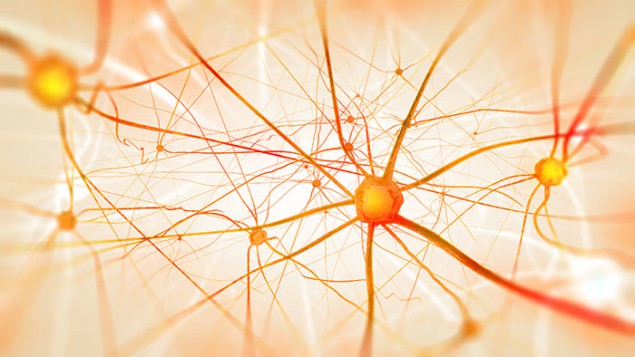
Consciousness appears to arise naturally as a result of a brain maximizing its information content. So says a group of scientists in Canada and France, which has studied how the electrical activity in people’s brains varies according to individuals’ conscious states. The researchers find that normal waking states are associated with maximum values of what they call a brain’s “entropy”.
Statistical mechanics is very good at explaining the macroscopic thermodynamic properties of physical systems in terms of the behaviour of those systems’ microscopic constituent particles. Emboldened by this success, physicists have increasingly been trying to do a similar thing with the brain: namely, using statistical mechanics to model networks of neurons. Key to this has been the study of synchronization – how the electrical activity of one set of neurons can oscillate in phase with that of another set. Synchronization in turn implies that those sets of neurons are physically tied to one another, just as oscillating physical systems, such as pendulums, become synchronized when they are connected together.
The latest work stems from the observation that consciousness, or at least the proper functioning of brains, is associated not with high or even low degrees of synchronicity between neurons but by middling amounts. Jose Luis Perez Velazquez, a biochemist at the University of Toronto, and colleagues hypothesized that what is maximized during consciousness is not connectivity itself but the number of different ways that a certain degree of connectivity can be achieved.
Many ways of connecting
Perez Velazquez’s colleague Ramon Guevarra Erra, a physicist at the Paris Descartes University, points out that there is only one way to connect each set of neurons in a network with every other set, just as there is only one way to have no connections at all. In contrast, he notes, there are many different ways that an intermediate medium-sized number of connections can be arranged.
To put their hypothesis to the test, the researchers used data previously collected by Perez Velazquez showing electric- and magnetic-field emissions from the brains of nine people, seven of whom suffered from epilepsy. With emissions recorded at dozens of places across the subjects’ scalps, the researchers analysed every possible pairing of these data “channels” to establish whether the emissions in each case were in phase with one another. They added up the number of synchronized pairs and plugged that figure along with the total number of all possible pairings into a fairly straightforward statistical formula to work out how many different brain configurations that level of synchronicity yields. They then took the logarithm of that number to establish the brain’s entropy.
The data were analysed in two parts. In one, they compared the emissions from four of the epileptic patients when undergoing a seizure and when in a normal “alert” state. In the second, they compared emissions from the other five individuals when sleeping and when awake. In both cases, the bottom line was the same: subjects’ brains display higher entropy, or a higher value of a similar quantity known as Lempel–Ziv (LZ) complexity, when in a fully conscious state.
Varying results
Guevarra Erra admits that the results are not watertight. Indeed, the LZ complexity of one of the four epileptic patients in the first analysis showed no change between seizure and alert states (although that person did remain conscious during part of the seizure). In another individual, LZ complexity actually increased in the second analysis while that person was asleep. Guevarra Erra says that he and his colleagues didn’t carry out a statistical analysis of their results in part because of the “very heterogeneous” nature of those results. But he nevertheless remains “highly confident” that the correlations they have identified are real, particularly, he argues, because they were seen in “two very different sets of data”.
Peter McClintock, a physicist who works on nonlinear dynamics at Lancaster University in the UK, describes the research as “intriguing” but says that the consciousness–entropy correlation should be confirmed using a larger number of subjects. He also suggests investigating “what happens in other brain states where consciousness is altered”, such as anaesthesia.
Emergent property
Perez Velazquez and colleagues argue that consciousness could simply be an “emergent property” of a system – the brain – that seeks to maximize information exchange and therefore entropy, since doing so aids the survival of the brain’s bearer by allowing them to better model their environment. On the question of entropy, however, Guevarra Erra is cautious. He says that personally he would like to have a better understanding of the physical processes taking place in the brain before employing the label “entropy”, explaining that Perez Velazquez was keen to use the term in their paper. One option, he says, would be to carry out fresh experiments that measure thermodynamic quantities in subjects’ brains. He notes, for example, that magnetic resonance imaging can be used to measure oxygenation, which is directly related to metabolism and therefore to the generation of heat.
Guevarra Erra adds that he would like to extend their investigations beyond the hospital to cover more subtle but general cognitive behaviour. The idea would be to monitor a person’s changing brain activity as they focus on carrying out a specific task, such as discriminating between musical tones or trying to find their way round a labyrinth. This, he says, should help to establish whether varying “entropy” correlates with degree of awareness as well as simply with the presence or absence of consciousness.
A paper describing the work will be published in Physical Review E and is also available on arXiv.



